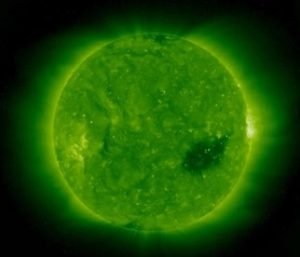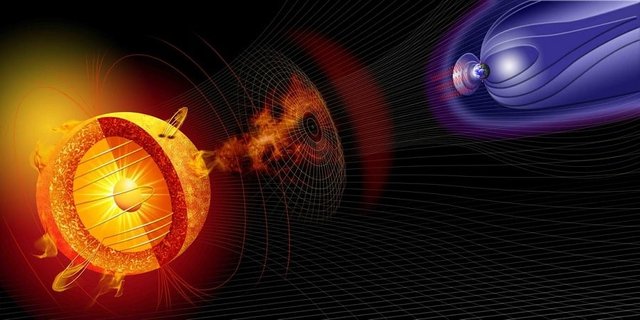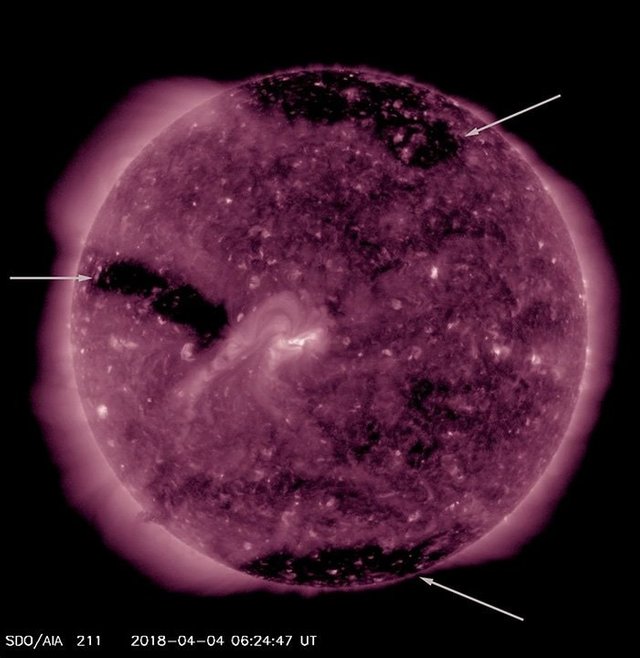Coronal holes and geomagnetic storms: what are the consequences for the Earth?
Coronal holes and geomagnetic storms: what are the consequences for the Earth?

Several solar flares captured by NASA's Solar Dynamics Observatory. | NASA's Space Flight Center / SDO / Genna Duberstein
Solar dynamics is a topic of interest for astrophysicists, because its study allows to better understand the structure of our star but also to predict its behavior. The different heliophysical models show that the Sun operates in an 11-year cycle, during which solar activity varies in intensity. In certain cases, particular surface configurations, called "coronal holes", appear and can lead to the production of geomagnetic storms towards the Earth.
First discovered by the German astronomer Heinrich Schwabe in 1843, the solar cycle is a period of about 11 years during which solar activity fluctuates and is characterized, among other things, by the appearance and disappearance of sunspots (less hot regions of the Sun's surface and magnetically more intense). Currently, we are in the 24th cycle , in a period called " solar minimum " (less solar activity).
During the solar minimum, the number of spots and solar flares decreases. However, other chaotic structures can form on the surface of our star. Indeed, the Sun has magnetic fields of surface divided into two categories: closed magnetic fields, for which the field lines come out and return to different points (loops); and the open magnetic fields, for which the field lines remain open towards the space.

Photograph by NASA Solar TErrestrial RElations Observatory, showing the solar disk with a coronal hole (dark spot). Credits: NASA / STEREO
These areas of open magnetic fields are called " coronal holes " because they appear as shadows on X-ray images. First observed in the 1960s using the Sydney Chris Cross radio telescope, the holes coronals are less hot than the rest of the solar surface and are the site of violent plasma ejections (ionized gas) forming solar winds . Because of the large amounts of material removed during these eruptions, the coronal holes are also less dense than their periphery.
When expelled to our planet, these solar winds can strike the Earth and cause magnetic disturbances of varying intensity, in the form of geomagnetic storms (or magnetic storms). When the solar particles come into contact with the Earth's magnetic field, they transfer a large amount of energy to the magnetosphere ; this energy overload leads to the acceleration of the magnetospheric plasma and to the increase of the intensity of the electric current in the magnetosphere and the ionosphere .
Depending on the intensity of the phenomenon, it can cause various disturbances on our planet. First, a sufficiently powerful solar wind could partially or completely damage satellite and terrestrial electrical systems (power grids, telecommunication systems, computer networks, car batteries, etc.). Electrical transformers are extremely vulnerable structures to induced geomagnetic currents and could be quickly saturated or destroyed during an intense magnetic storm.
High frequency communication systems pass through the ionosphere for the propagation of long distance radio signals. Ionospheric electrical disturbances could lead to the random and erratic absorption / reflection of radio waves and paralyze all the planetary communication pathways.
Ionospheric disturbance would also affect GPS signals by flicker (density variation of ionospheric layers randomly reflecting GPS signals). Finally, the electronic structures of the pipelines would also be very vulnerable to this kind of event. The consequences of such radiation on the human body are still being studied, including the disturbance of biological compasses of certain animals.

During a geomagnetic storm, the solar wind impacts the magnetosphere and the terrestrial ionosphere, which can lead to variable disturbances of terrestrial electrical systems. Credits: NASA
The intensity of a geomagnetic storm is given by an integer from 0 to 9, called " K-index ", measuring the level of disturbance of the horizontal component of the Earth's magnetic field. A K-index between 0 and 4 indicates a calm magnetic situation. From 5, this indicates the appearance of a geomagnetic storm. The American National Oceanic and Atmospheric Administration (NOAA) uses an evaluation system equivalent to the K-index called " G scale ". This scale ranges from G1 to G5: G1 indicating a minor solar storm (K = 5) and G5 an extreme solar storm (K = 9).
Fortunately, such devastating storms are rare. Among those that have significantly affected the Earth is the solar storm of 1859; considered the most violent recorded geomagnetic storm, it led to the disruption and destruction of various electrical telegraph systems, as well as the appearance of many polar auroras. Since 1859, only 4 other notable solar storms have been recorded.

Three new coronal holes appeared on the Sun's surface, leading to the appearance of a G1-level geomagnetic storm since April 10, 2018. Credits: NASA / SDO / AIA
Moreover, since April 10, a G1 geomagnetic storm hits the Earth following the appearance of three coronal holes on the surface of the Sun, according to NOAA observations . And except for some electrical fluctuations and disturbances in our televisions as well as the appearance of polar aurora at high latitudes, the phenomenon should go completely unnoticed.
This article appeared first on https://trustmyscience.com/trous-coronaux-tempetes-geomagnetiques-consequences-terre/
Reproduction rights CC BY 4.0 License (Attribution - Sharing under the same conditions)
I follow all the people who follows me! (If I have time, enough bandwidth and steem power...)

My 5 favorite posts:
 Solar: Number 1 in global energy investments
Solar: Number 1 in global energy investments
 Boob morning! Thanks to my followers and upvoters! My sexy gift:
Boob morning! Thanks to my followers and upvoters! My sexy gift:
 SteemIt Daily Report : 6 upvoted and 30 resteemed!
SteemIt Daily Report : 6 upvoted and 30 resteemed!
 Climate justice: in Colombia, a historic decision against deforestation
Climate justice: in Colombia, a historic decision against deforestation
 SteemIt Daily report : 32 upvoted and 76 ReSteemed! Still flagged by the troll https://steemit.com/@abusereports
SteemIt Daily report : 32 upvoted and 76 ReSteemed! Still flagged by the troll https://steemit.com/@abusereports


@cleverbot @banjo @catfacts @witzbot @clever


All the pictures posted here are free pictures found on free websites, public instagram accounts or from websites allowing the sharing of their posts
Reproduction rights CC BY 4.0 License (Attribution - Sharing under the same conditions)
How to defeat the trolls flaggers
Diätregel #1: Wenn es schmeckt, spuck es aus!
Du willst, dass meine △ mehr bringen? Dann stärke mich doch bitte, indem du mir auch ein △ gibst 👍.
Alle Erlöse fließen zu 100% in meine STEEM POWER, bis ich min. 1000 erreicht habe (auch verdiente STEEM DOLLAR werden in STEEM POWER umgewandelt).
Luna Lovegood is my favourite. Who is your favourite character?
I don't troll. You should ask somebody else that.
Congratulations @mybestnews! You have completed some achievement on Steemit and have been rewarded with new badge(s) :
Click on any badge to view your own Board of Honor on SteemitBoard.
For more information about SteemitBoard, click here
If you no longer want to receive notifications, reply to this comment with the word
STOP